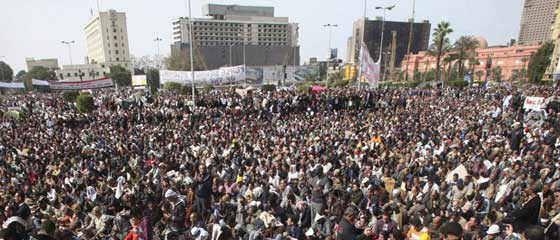
Time Line of Egypt Demonstrations 25th Jan - 11th Feb 2011
"First they ignore you, then they ridicule you, then they fight you, then you win." -- Mahatma Gandhi
On the 25th January 2011 the world watched in awe as the people of Egypt united across the country in unprecedented scenes of protest and demonstration
Spurned on by the recent events in Tunisia that saw a longstanding dictator deposed, the Egyptian people spoke seemingly with one clear voice and demanded an alternative Egypt.
Over the next 18 days massive protests took place that at first shocked, then worried and ultimately inspired people across the globe.
During the course of the demonstrations more than 300 Egyptians lost their lives, while thousands more were injured or arrested. Men, women and children camped out in Cairo.
As food grew thin on the shelves and the banks closed their doors, everyday Egyptians formed neighbourhood watch groups to protect their communities, their homes and their families.
At first the president made small concessions while ignoring the greater requests for his resignation. Western governments too were hesitant in choosing sides, favouring fence sitting rhetoric.
As momentum grew so too did the crowds, made up of Egyptians from all walks of life. Parallel protests took place across the world and foreign governments gradually upped the pressure on the Egyptian president.
The army, while ever present among the protesters Cairo remained neutral stating only that they would not use force against the Egyptian people.
Finally on the 11th February newly appoint Vice President Omar Suleiman announced the resignation of Hosni Mubarak, unelected president of Egypt for more than thirty years.
Although the protests took place across the country and indeed the world, Cairo’s Tahrir Square was the beating heart of the revolution and the principle focus of the world’s media.
It went a little something like this:
Timeline
Egypt’s Police Day January 25th 2011
On a national holiday typically celebrating the police, thousands of Egyptians fill the streets to demand an end to the current regime.
Renamed by protesters as the ‘Day of Wrath’, there are numerous clashes with the police. Protests take place in Cairo, Suez, Ismailia and other Nile Delta cities
January 26th 2011
The government’s ban on protesters does little to deter them and people take to the streets in unprecedented numbers. The security forces reportedly arrest more than 500 demonstrators.
January 27th 2011
Mohamed El Baradei, the former head of the International Atomic Energy Agency (IAEA) and outspoken critic of the president returns to Egypt.
January 28th 2011
Reuters report that 24 people are killed and more than 1000 are injured in the clashes across the country. A curfew is implemented.
Tanks roll into the cities carrying armoured personnel. They are warmly received by protesters and assume a neutral role. Their remit is unclear.
Egyptian mobile and broadband networks are shutdown. Social media continues to provide an online backchannel of the revolution.
January 29th 2011
In the early of hours of the morning, Mubarak makes his first televised speech since the demonstrations began. He announces that a new government will be installed to comply with protesters wishes.
Later that morning the Egyptian media shows images of a new vice president being sworn in. Former intelligence Chief Omar Suleiman assumes the role.
This is the first time that Egypt has had a vice president since Mubarak himself held the position from 1975 to 1981.
The police withdraw from the streets and armed thugs begin to cause havoc. Egyptians form armed neighbourhood watch groups to protect their communities.
The army remain neutral.
The curfew this evening is set to 4pm. Thousands of protesters remain on the streets in defiance.
Looters break into the Egyptian museum and vandalise two mummies.
January 30th 2011
Finally President Obama makes his voice heard calling for an ‘orderly transition to democracy’.
He fails to comment on whether Mubarak should stay or go.
Mohammed El Baradei is televised on Al Jazeera as he joins protestors in Tahrir square.
Egypt’s banks are closed and protests intensify in Alexandria as Mubarak's picture is torn down.
Al Jazeera is taken off the air in Egypt.
January 31st 2011
Egypt’s army renounces the use of force against its own people and media shows images or soldiers and protesters united. A new government is sworn in and newly elected Vice President Suleiman makes his first speech.
Once again thousands of protesters defy the curfew in Tahrir square and the gatherings are described as ‘festive’ by reporters.
Parallel protests take place across the world including Wilton Place in London, outside of the house believed to be owned by Gamal Mubarak, the son of Egypt’s president.
Banks remain closed and food supplies dwindle yet state media remains fully operational.
Al Jazeera report their staff are being arrested in Cairo.
Word spreads across the airways of a million man march scheduled to take place the following day. The army deploy concrete walls in preparation.
February 1st 2011
Mubarak speaks again and declares he will not stand for re-election in September.
Unsatisfied, protesters take to the streets across the country in the greatest numbers yet.
February 2nd 2011
The curfew is eased and the army calls for protesters to stay at home. Although the calls are ignored the army remain neutral, intervening only to form a barrier between pro-Mubarak and anti-Mubarak supporters.
February 4th 2011
Dubbed ‘The Day of Departure’ Tahrir Square is once again full of protesters.
Baradei speaks for the first time at length to the BBC in extended interview.
Seemingly unfazed Protesters announce that the following week will be ‘resistance week’.
In Alexandria protesters erect giant screens to show Al Jazeera.
February 5th 2011
President Mubarak’s son Gamal formerly resigns from the government while foreign journalists are being arrested and detained by Egyptian security forces.
February 6th 2011
The government hold talk with opposition groups including the banned Muslim Brotherhood. Chaired by the Vice President Suleiman the two sides agree to draft a roadmap for talks and a committee is set up to study constitutional issues.
Banks finally reopen for the first time in a week.
February 7th 2011
The protests continue and demonstrators vow to remain in Tahrir square until Mubarak resigns.
February 8th 2011
Egyptians stage one of the biggest protests yet.
34 political prisoners are freed from prison including members of the banned Muslim brotherhood.
Blogger and Google employer Wael Ghonim speaks after his release from prison.
February 9th 2011
Reuters reports four people are killed and more wounded in clashes between demonstrators in the New Valley, South of Cairo.
Labour unions join the protests and thousands of factory workers take to the streets.
February 10th 2011
Doctors and lawyers join the protests today.
Crowds wait expectantly across the country as news hits that Mubarak is going to address the nation.
The address is disappointing. Mubarak fails to resign as expected and instead promises to oversee a peaceful transfer of power in September.
Al Jazeera shows images of angry crowds in Tahrir square waving shoes and chanting, ‘tomorrow!’.
Egypt braces for massive protests.
February 11th 2011
Vice President Omar Suleiman announces Mubarak’s resignation handing over power to the Supreme council of the armed forces on what is dubbed by the news media as ‘Farewell Friday’.
For More Information:
Totally Cool Pix - Provocative images from the Egypt Demonstrations
Jan 25 Voices - The feed to follow for developments in Egypt reported by Egyptians




